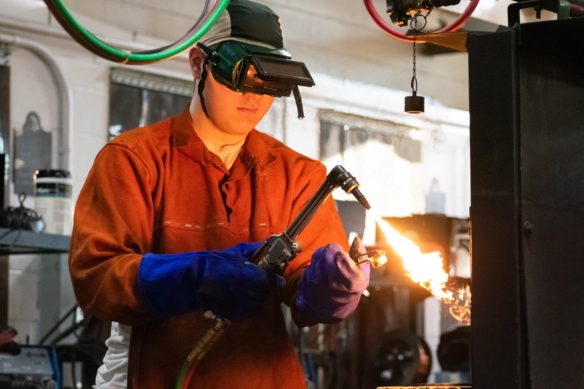
A student works during a welding class at Corbin Area Technology Center. Kiley Whitaker, the assistant director of the Kentucky Department of Education’s Division of Technical Schools and Continuous Improvement, said data shows that students who complete a career and technical education pathway earn degrees and are employed at higher rates and higher wages than those who do not.
Photo by Jacob Perkins, Oct. 2, 2019
- Data underscores the importance of revised graduation requirements that took effect earlier this year.
- Career and technical education and participation in career pathways has been shown to improve student outcomes.
By Mike Marsee
mike.marsee@education.ky.gov
When Kiley Whitaker wants to explain to schools why Kentucky’s graduation requirements have changed, he points to the numbers.
Whitaker, the assistant director of the Kentucky Department of Education’s Division of Technical Schools and Continuous Improvement, has examined statistics that look into postsecondary outcomes for Kentucky students, and he didn’t like what he found.
He said Kentucky schools must address a “student outcomes crisis” in which the number of students who are achieving success in postsecondary education and in the workforce isn’t what it should be.
“I’ve been looking at quantitative data and that paints a pretty ugly picture. It’s not the full picture, but the picture is not where we want it today,” Whitaker said. “When people ask, ‘Why new graduation requirements?’ ‘Why new ILPs?’ et cetera, my answer is, ‘Because change is needed.’”
Whitaker has taken his message about the student outcomes crisis to multiple audiences at the same time that KDE has developed and begun to implement new minimum graduation requirements, which became law in April. He said the data he found supports the need for the changes, which add graduation prerequisites and graduation qualifiers to ensure students have basic math and reading skills, as well as experiences that can help them be prepared to enter college or the workforce.
“It was a perfect time for me to say, ‘Here’s the reasoning behind this,’” he said.
He points to three numbers from reports by the Kentucky Center for Statistics (KyStats) that he said underscore the need for change:
- About 70% of Kentucky’s high school graduates go on to attend a two- or four-year college or university in Kentucky.
- Of those students, only about 40% earned a postsecondary degree, diploma or certificate.
- Of those students, only about 75% have gotten a job within three years.
“You start to see that a very small percentage of our students are being truly successful after high school,” Whitaker said.

Kiley Whitaker, the assistant director of the Kentucky Department of Education’s Division of Technical Schools and Continuous Improvement, discusses student outcomes during a presentation at the Career and Technical Education Summer Program in Louisville. Whitaker said Kentucky schools must address a “student outcomes crisis” in which the number of students who are achieving success in postsecondary education and in the workforce isn’t what it should be.
Photo by Mike Marsee, July 24, 2019
Whitaker spoke on the student outcomes crisis at KDE’s Persistence to Graduation Summit and at the Kentucky Association for Career and Technical Education’s (KACTE) CTE Summer Program, as well as at other conferences and trainings.
It will be one of the primary topics at a series of seven regional meetings coinciding with CTE Month in February that will be targeted to school counselors, high school principals and other school leaders.
When Whitaker assembled a panel to address the topic at the KACTE conference this summer, he included representatives from KyStats, the Kentucky Higher Education Assistance Authority (KHEAA) and the Kentucky Community and Technical College System (KCTCS) to drive home points about the keys to postsecondary success and how career and technical education plays a part in that.
“CTE makes a difference for students. I have hard data to back that up,” Whitaker said. “Kids who complete a CTE pathway have a higher degree rate, their employment rate is higher and they make more money versus kids who do not.”
Logan Rupard, a data expert with KyStats, cited data from his agency’s report, “2017 Outcomes for 2010 High School Graduates,” to show that the difference between the median wage for high school graduates six years after high school (about $20,000) was significantly lower than that of those holding an associate’s degree (about $30,000) or a bachelor’s degree (about $33,000).
Harmony Little, a project manager in KCTCS’ Department of Economic Development and Workforce Solutions, stressed why it is important for students to have a plan when they enter college.
“Make every credit count,” Little said. “It’s really important for you to know what a student wants to do after high school. We need to start having conversations about the right courses for students to take. ‘Does this fit with a student’s plans after high school?’
“If we do this right, if we focus on what students want out of high school, if we focus on maximizing the dual credit benefit, we can help change the numbers.”
KHEAA’s Dual Credit Scholarship Program and Work Ready Kentucky Scholarship can help students hone in on their goals and work toward them while still in high school. Apprenticeships have become another valuable postsecondary option for high school students, and Kentucky Educational Excellence Scholarship (KEES) funds now can be used toward registered apprenticeships.
Whitaker said data from KyStats clearly shows that students who complete career pathways are employed at a higher percentage and earn higher wages and that dual credit, work experience, apprenticeships and pre-apprenticeships and industry certifications are keys to postsecondary success.
“It shows that going through a CTE pathway, participating in career counseling, getting some kind of certification, something in high school will help get you a job,” he said. “Those things matter. Those are indicators of additional success that students could have after high school. They also help to explain to schools why those graduation qualifiers are there.”
MORE INFO …
Kiley Whitaker kiley.whitaker@education.ky.gov



Leave A Comment